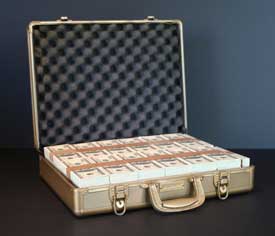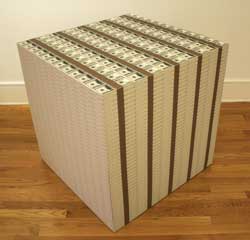Money, Honey?
Srdjan Loncar Explores “Value” By Sculpting Illusion
by Jenelle Davis, ARTVOICES
Srdjan Loncar is making money, but it’s not about the profit. He hopes that by the time you’re reading this article, New Orleans will be consumed with blissful residents, toting around their newly acquired golden suitcases, a million dollars richer.

Value, 2008
Loncar employs a wealth of dichotomies in his work, often linking several pieces through this duality. His ideological and stylistic consistencies are well reflected in a trio of installations he created for Prospect 1. Value, perception, and illusion are all themes that permeate through his most recent assemblages.
Taking advantage of the Mint’s architecture, Loncar’s piece entitled Value consists of a large pile of “money” installed in one vault and a second pile of golden suitcases in an adjacent vault. An attendant who will facilitate the sale of the cases to any interested buyers will sit at a large desk outside of these rooms. Loncar’s money was crafted out of wooden blocks and then covered by a detailed print of a stack of bills, secured by a band declaring its US Mint origins.
The starting selling price of a million printed dollars is $500 per golden case. The buyer can then walk away from the Mint with their new-found fortune. Loncar hopes that with the popularity of the sales, the price of the cases will inflate.
Louisiana ArtWorks features a second conceptually linked piece, Burning Car, a silver Toyota Camry, the most popular car and most popular car color, engulfed in gargantuan flames. Loncar enlisted the help of a tattoo artist to successfully hew comic-book-like flames out of enormous blocks of Styrofoam.
To conclude the look of the inferno, working in his signature style, Loncar affixed pixilated red, yellow and orange photographs to the Styrofoam. The catch? All of the photographs were taken at Wal-Mart and the car, Loncar laughs, is “consumed in flames.”
Lastly, the installation at Arthur Roger Gallery completes the triangle with a melange of elements from both Value and Burning Car. Instead of a pile of money, Loncar constructed metal cubes and covered them with the same printed money as used in Value. A cube of actual money that size is worth $49,200, but Loncar points out that for his money, “the aesthetic of the cube dictates its worth.”
Ten of these will be placed along the walls leading up to another burning car in the middle, “creating a mausoleum, or acting like a tombstone for the car,” says Loncar. This time the car is a toy Hummer and the flames come from pictures of oil well fires in Iraq. Both fiery displays shriek of the perils of consumerism, be it part of a wealthy or more common lifestyle.
Recent current events have added a serendipitous aspect to this work.
“The financial meltdown was the cream on top,” Loncar beams, “even though it was just a coincidence.”
Everything is intricately intertwined and, as Loncar explains, value is the key with these recent installations.
“I was thinking about the word value,” says Loncar, “what we value, the value of money, the value of art, the value put on this piece, the value of the materials used to make the piece…”
He goes on to explain how literally making money started forcing him to think like a financial institution.
“Working with art should be a conversation; it’s all about what I learn from it or what others learn from it.” For him, this is what the hard work is all about.
Loncar sculpts objects using mainly Styrofoam or wood as a base, then covers these life-sized reproductions with photographs that are either of the objects themselves or of ones that resemble them closely. These images that cover his sculptures are often captured from television or computer screen, heightening the illusion of a representation of the real object.
As Loncar describes, he’s “rendering the 2-D into the 3-D.” His intention is to create an illusion that challenges the viewer to look at everyday objects from a new perspective.
Originally from Croatia, Loncar moved to New Orleans while very young and has resided here since 1991. He’s received both a B.FA. and an M.F.A. from the University of New Orleans [UNO], but only at the end of a long road of trying his hand in other areas, including an initial attempt to gain a degree in Hotel and Business Management.
However, it was an unlikely combination of Loncar’s artistic dabbling and his positive experiences in UNO cooking classes that jumpstarted his career in the arts.
“We had a large function to organize and I really enjoyed it,” says Loncar, “including being asked to carve an ice sculpture.”
Loncar adds that working on all elements of the presentation was invigorating. Already experimenting with sculpture in the Fine Arts department, transferring into a full-time fine art program was an effortless transition.

$48,000,000, 2008
During grad school, Loncar began working in his signature large-scale style, combining his preferred mediums of photography and sculpture. He lists some of his early influences as Tom Friedman and Tim Hawkinson, both exceptional sculptors and conceptual artists.
Today, in addition to the media and TV, Loncar finds his inspiration on a more personal level. Conversations with other artists, including his wife, Adrian Price, provide a multifaceted platform for discussion.
“My wife and I have a strong relationship throwing ideas off one another,” says Loncar.
He adds that with the influx of artists in town for Prospect, he has had extra opportunities to enjoy conversations over morning coffee with a wide range of artists.
“These conversations aren’t always directly criticizing artwork,” says Loncar, “they are about getting a different perspective.”
Loncar continues to favor ambitious installations that are consistently reflective of his focus on, as he explains, “deconstructing an object and then reconstructing it in another way.” He generally includes pertinent and timely issues in his work, including his thesis show, which focused on cloning, a highly debated issue at the time.
In recent months, Loncar finds himself dividing his time between his two studios and the four venues where he will be showing work for Prospect 1. Although racing around the city and trying to meet a deadline is a more than stressful full-time job, Loncar remains focused, determined, confident and very devoted to his art. His enthusiasm and dedication is contagious and reassuring.
Quoting a fellow artist, Loncar lives by the trope, “being an artist is not a sprint, it’s a marathon.”
He is convincingly in the business for his love of art and his fervor for continuously producing original and thought provoking work—not out of habit, and, as he reiterates, not for the money either.
“I just want to see this happen,” says Loncar. “It’s not about the profit.”
Loncar’s passion for his work is brilliantly conspicuous. His interest in personally learning while sharing the possibility of broadening one”s horizons through his art is a refreshing facet of his creative output. In the near future, he intends to continue working with Value, perhaps adapting it for a European market. For the next few months at least, he’ll undoubtedly be taking a short break to watch his golden dreams unfold.
